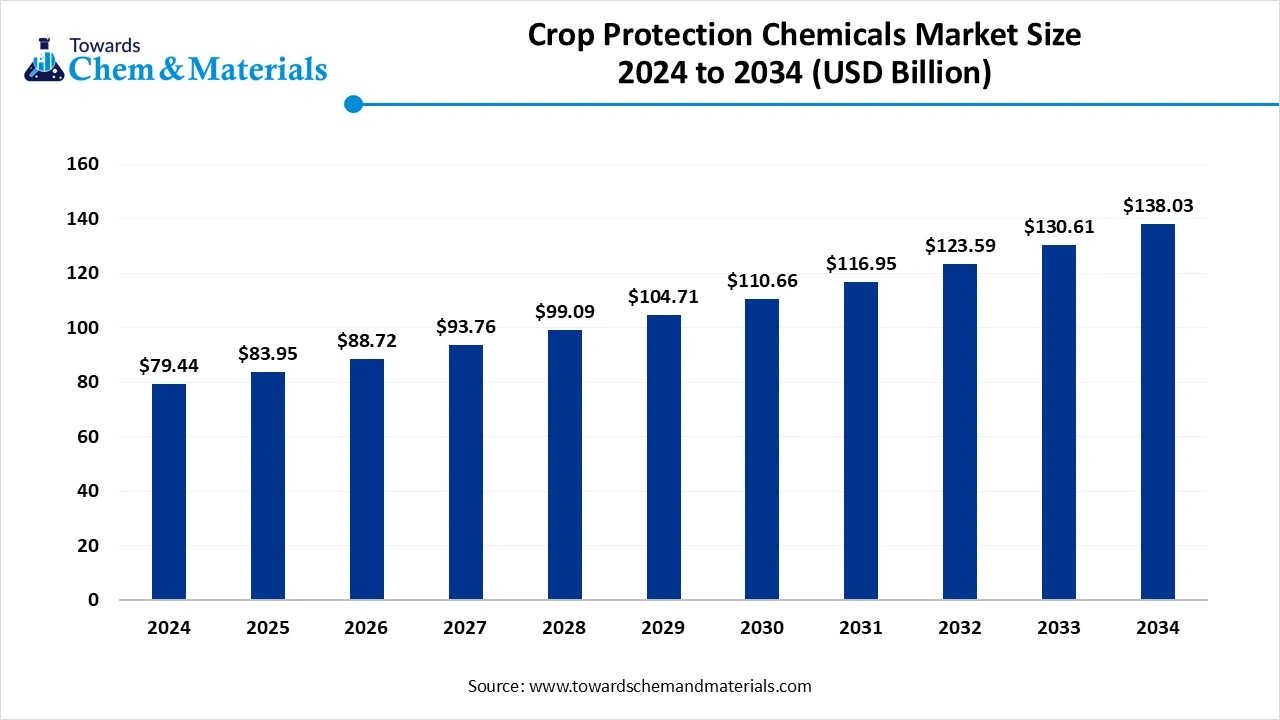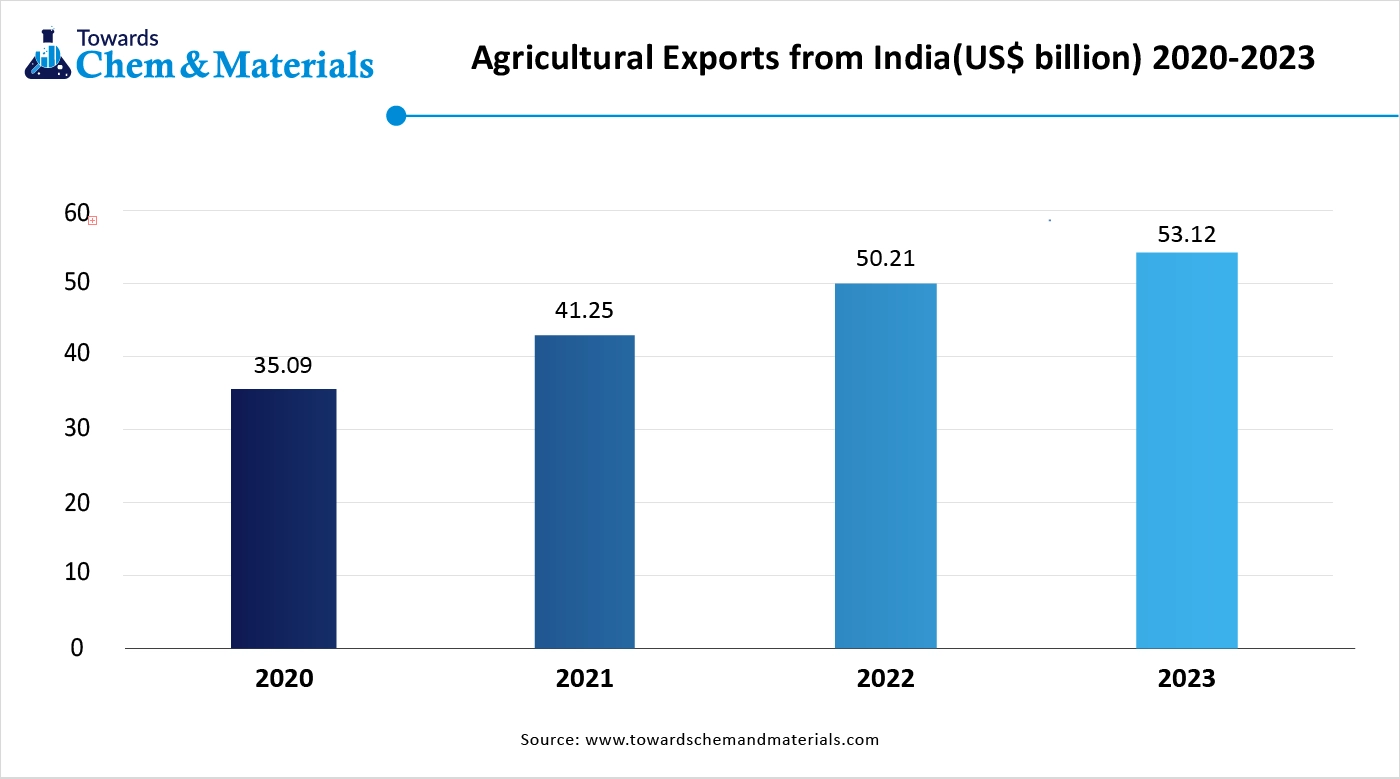November 2025
The crop protection chemicals market size accounted for USD 79.44 billion in 2024 and is predicted to increase from USD 83.95 billion in 2025 to approximately USD 138.03 billion by 2034, expanding at a CAGR of 5.68% from 2025 to 2034. The growing demand for higher crop yields and advancements in farming techniques drive the market growth.

Crop protection chemicals market growth is driven by a rise in the incidence of diseases & pests, the development of bio-based solutions, growing food demand, the use of modern farming technology, and the focus on maximizing crop yields.
Crop protection chemicals are substances used in agricultural activities to protect crops from weeds, pests, & diseases. They offer benefits like enhancing crop yields, improving the quality of the crop, extending the shelf life of agricultural products, lowering resource use, and helping in conservation. Crop protection chemicals are applied in areas like soil, plants, and storage by using methods like precision farming, spraying, & manual application.
| Report Attributes | Details |
| Market Size in 2025 | USD 83.95 Billion |
| Expected Size by 2034 | USD 138.03 Billion |
| Growth Rate from 2025 to 2034 | CAGR 5.68% |
| Base Year of Estimation | 2024 |
| Forecast Period | 2025 - 2034 |
| Dominant Region | North America |
| Segment Covered | By Products, By Crop Type, By Source, By Form, By Mode of Application, By Region |
| Key Companies Profiled | Adama Agricultural Solutions Ltd., Arysta Lifesciences Corporation, America Vanguard Corporation, Jiangsu Yangnong Chemical Group Co. Ltd, Corteva, Syngenta Group, FMC Corporation |
The crop protection chemicals market is undergoing key technological shifts driven by the demand for reducing environmental impact, enhancing crop health, and improving sustainability. One of the most significant shifts is the adoption of artificial intelligence (AI) improves the development of crop protection solutions and offers faster discovery of solutions.
AI helps in the prediction of effective molecules against weeds, pests, or pathogens, and easily predicts safety. AI supports the development of intelligent spraying systems and helps in early diagnosis of crop disease. AI suggests to farmers whether to use biological solutions or chemical pesticides. For instance, Bayer’s CropKey is an AI-enabled platform that uses AI for the discovery of new active ingredients for herbicides, pesticides, & fungicides.
| Types | Description | Application Area | Application Methods |
| Insecticides | The type of chemical used to control, kill, & repel insects like aphids, locusts, and moths to prevent damage to crops. |
|
|
| Herbicides | The chemical is used to control or kill unwanted weed growth. |
|
|
| Fungicides | The chemical is used to prevent, kill, or inhibit the growth of fungi on plants. |
|
|
| Plant Growth Regulators | The chemicals used to regulate the growth of plants or modify plant growth, like aiding fruit ripening or promoting flowering. |
|
|
Growing Agriculture Sector Drives Expansion of the Market
The growing population and expansion of the agriculture sector across various regions increase demand for crop protection chemicals. The higher demand for food and focus on the maximization of crop yields requires fungicides, insecticides, & herbicides. The increasing rate of diseases, pests, & weeds on crops, and the adoption of modern agricultural practices, require crop protection chemicals.
The increasing preference for high-value crops like vegetables & fruits and modernization in agricultural practices require crop protection chemicals. The changing dietary preferences and strong government support for sustainable agricultural practices increase demand for crop protection chemicals. The growing agriculture sector creates an opportunity for the growth of the crop protection chemicals market.

Despite several benefits of crop protection chemicals in agricultural practices, the high R&D costs restrict market growth. Factors like complex regulatory processes, focus on product safety, discovery of new active ingredients, and comprehensive testing increase the cost.
The extensive safety evaluations and lengthy regulatory processes require a high cost. The long development process and manufacturing of environmentally friendly products require a high cost. The complex process for the development of active ingredients increases the cost. The high R&D cost hampers the growth of the crop protection chemicals market.
Why the Herbicides Segment Dominates the Crop Protection Chemicals Market?
The herbicides segment dominated the crop protection chemicals market in 2024. The adoption of modern farming technology and the development of genetically modified crops increase demand for herbicides. The focus on maximizing crop yields and cost-effectiveness increases the adoption of herbicides. The focus on controlling various weeds and high cultivation of grains & cereals requires herbicides, driving the overall market growth.
The insecticides segment is the fastest-growing in the market during the forecast period. The growing food production and strong focus on food security increase the adoption of insecticides. The focus on preventing crop loss from insects like whiteflies, aphids, & armyworms requires insecticides. The increasing production of high-quality crops and focus on post-harvest protection require insecticides, supporting the overall market growth.
How did the Cereals and Grains Segment hold the Largest Share of the Crop Protection Chemicals Market?
The cereals and grains segment held the largest revenue share of the crop protection chemicals market in 2024. The growing cultivation of cereals & grains like corn, rice, & wheat increases demand for crop protection chemicals. The strong focus on food security and increasing risk of weeds, pests, & diseases on cereals & grains requires crop protection solutions. The high consumption of cereals and grains drives the overall market growth.
The fruits & vegetables segment is experiencing the fastest growth in the market during the forecast period. The growing awareness about the benefits of fruits & vegetables in the diet and focus on agricultural productivity increases demand for crop protection chemicals. The high consumption of fruits & vegetables and increasing health consciousness among consumer supports the overall market growth.
Why the Synthetic Chemicals Segment is Dominating the Crop Protection Chemicals Market?
The synthetic chemicals segment dominated the crop protection chemicals market in 2024. The low production cost and high efficacy against diseases, pests, & weeds increase the adoption of synthetic chemicals. The ease of availability and longer residual effect increase the adoption of synthetic chemicals. The focus on increasing crop yields and ease of application drives the overall market growth.
The biologicals segment is the fastest-growing in the market during the forecast period. The growing awareness about environmental impact and the high demand for organic food increase the adoption of biologicals. The stricter government regulations on synthetic chemicals and the adoption of sustainable agricultural practices increase demand for biologicals. The strong focus on improving soil health and production of better quality crops requires biologicals, supporting the overall market growth.
Which Form Held the Largest Share in the Crop Protection Chemicals Market?
The liquid segment held the largest revenue share of the crop protection chemicals market in 2024. The adoption of precision agriculture and the focus on uniform distribution increase the adoption of the liquid form. The availability of application methods like aerial & ground sprayers helps the market growth. The easy-to-handle and high compatibility with fertilizers in liquid forms drive the overall market growth.
The dry segment is experiencing the fastest growth in the market during the forecast period. The strong focus on food security and the adoption of precision agriculture increases demand for dry form. The easy blending process with other soil amendments and the focus on enhancing crop efficacy require a dry form. The growing soil treatment and cost-effectiveness support the overall growth of the market.
How Foliar Spray Segment Dominated the Crop Protection Chemicals Market?
The foliar spray segment dominated the market in 2024. The focus on lowering crop damage and ease of application increases the adoption of foliar spray. The high production of crops like vegetables, field crops, and fruits requires foliar spray. The strong focus on minimizing chemical needs and uniform distribution of chemicals increases demand for foliar spray, driving the overall market growth.
The seed treatment segment is the fastest-growing in the market during the forecast period. The production of higher crop yields and the adoption of sustainable farming practices increase demand for seed treatment. The strong focus on controlling pests on crops and the need for enhancing germination require seed treatment. The stringent regulations on pesticide use and the development of genetically modified seeds require seed treatment, supporting the overall market growth.
North America Crop Protection Chemicals Market Trends
North America dominated the crop protection chemicals market in 2024. The presence of vast agricultural land and high production of a variety of crops increases demand for crop protection chemicals. The adoption of advanced irrigation systems and precision farming helps market growth. The production of major crops like soybeans, cotton, corn, & wheat, and a focus on maximizing agricultural productivity, increases adoption of crop protection chemicals, driving the overall market growth.
Crop Protection Chemicals Role in the United States
The United States is a major contributor to the crop protection chemicals market. The presence of a large agricultural landscape and high production of staple crops increases demand for crop protection chemicals. The adoption of advanced agricultural technology and a robust regulatory framework, like the USDA & EPA, develops crop protection chemicals. The strong focus on food security supports the overall market growth.
Asia Pacific Crop Protection Chemicals Market Trends
Asia Pacific is experiencing the fastest growth in the market during the forecast period. The growing production of food and a strong focus on food security increase demand for crop protection chemicals. The limited arable land and high population density require crop protection chemicals. The adoption of modern farming practices and the expansion of high-value crops increase demand for crop protection chemicals. The growing manufacturing of crop protection chemicals in countries like China drives the overall market growth.
Growing Population Drives Crop Protection Chemicals Growth in China
China is a key contributor to the market.The growing population and strong focus on higher crop yields increase the adoption of crop protection chemicals. The manufacturing base of formulated pesticides and active ingredients helps market growth. The modernization of agricultural practices and government support for sustainable agriculture drive the overall market growth.
By Products
By Crop Type
By Source
By Form
By Mode of Application
By Region
November 2025
November 2025
November 2025
November 2025